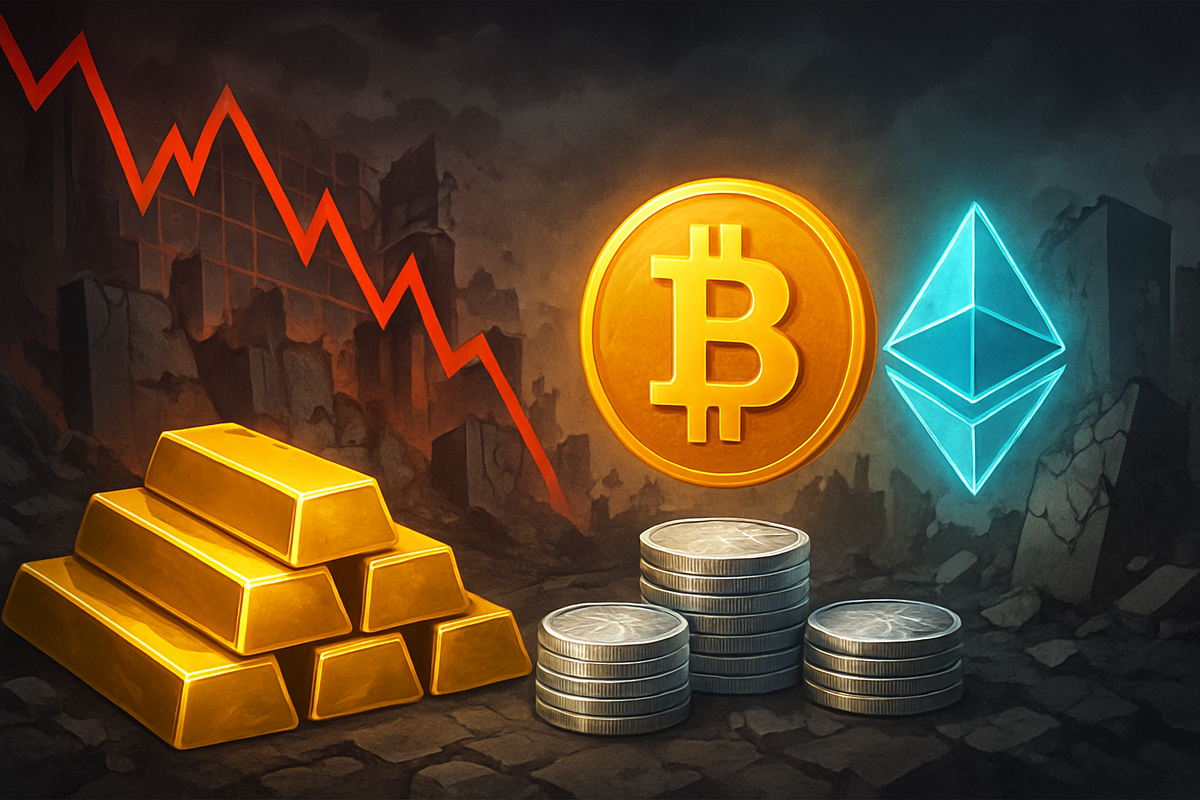
As global financial markets brace for potential turbulence, renowned author and financial commentator Robert Kiyosaki has once again issued a dire warning, asserting that a "massive crash" has begun. In a series of emphatic statements throughout 2025, culminating in a stark message on November 1st, Kiyosaki has urged investors to abandon traditional "paper assets" and instead seek refuge in what he terms "real money": gold, silver, Bitcoin, and Ethereum. His pronouncements have sent ripples through the investment community, prompting a renewed debate about portfolio diversification and the future stability of the global economy.
Kiyosaki's persistent warnings underscore a deep-seated skepticism about the current financial system, which he believes is teetering on the brink due to excessive debt and the continuous devaluation of fiat currencies by central banks. His latest call to action on November 1, 2025, stating "MASSIVE CRASH BEGINNING: Millions will be wiped out. Protect yourself. Silver, gold, Bitcoin, Ethereum investors will protect you. Take care," highlights his conviction that the time for preparation is now.
Kiyosaki's Prophecy: A Detailed Look at the "Biggest Crash in History"
Robert Kiyosaki's warnings about an impending financial catastrophe have been a consistent theme throughout 2025, intensifying as the year progressed. His predictions are not new, with his 2013 book, "Rich Dad's Prophecy," foretelling a significant market collapse. However, his recent pronouncements have been more urgent and specific, pinpointing 2025 as a pivotal year for a "global financial meltdown."
The timeline of his recent warnings paints a picture of escalating concern:
- November 1, 2025: Kiyosaki posted on X (formerly Twitter), declaring a "MASSIVE CRASH BEGINNING" and advising immediate shifts to gold, silver, Bitcoin, and Ethereum. He specifically predicted severe consequences for those holding traditional assets.
- October 12, 2025: He reiterated his belief that "the biggest crash in world history" would unfold this year, citing his decades-old prophecy and warning about the wiping out of Baby Boomer retirements.
- October 8, 2025: Kiyosaki questioned the future of the U.S. Dollar, stating, "END of US Dollar? Adding to my gold, silver, Bitcoin, and Ethereum stack. Savers of US dollars are losers. Be a winner. Take care."
- July 23, 2025: He continued his "Savers are losers" mantra, criticizing the Federal Reserve's "fake money" policies.
- June 23, 2025: Kiyosaki identified 2025 as the "pivotal year" for the "biggest crash in history," attributing it to inflation and job losses fueled by artificial intelligence.
- April 4, 2025: He announced that "That stock market crash arrived today. We are definitely in a RECESSION and more than likely…a DEPRESSION."
- February 2025: Earlier in the year, Kiyosaki had specifically predicted that the "biggest stock market crash in history" would occur in February, referencing his 2013 book.
Kiyosaki's consistent message is that the current financial system, fueled by what he calls "fake money" and excessive debt, is unsustainable. He views the Federal Reserve's quantitative easing and low-interest-rate policies as detrimental, leading to inflation and devaluing the purchasing power of traditional currencies. Key players in this narrative include individual investors grappling with market uncertainty, central banks influencing monetary policy, and governments managing national debts. Initial market reactions to Kiyosaki's warnings are often mixed; while some dismiss them as sensationalism, a significant portion of his followers and a growing segment of the public are exploring alternative asset classes, contributing to increased interest in precious metals and cryptocurrencies.
Market Implications: Winners and Losers in a Shifting Landscape
Should Kiyosaki's predictions of a "massive crash" materialize and lead to a widespread flight from traditional assets, several sectors and companies stand to be significantly impacted, creating both winners and losers.
Potential Winners:
- Precious Metals Miners: Companies involved in the extraction and production of gold and silver would likely see increased demand and potentially higher prices for their commodities. Major players like Barrick Gold (NYSE: GOLD), Newmont (NYSE: NEM), and Agnico Eagle Mines (NYSE: AEM) in the gold sector, and Pan American Silver (NASDAQ: PAAS), Fortuna Silver Mines (NYSE: FSM), and First Majestic Silver (NYSE: AG) in the silver sector, could experience substantial gains. Their stock performance is often correlated with the underlying commodity prices, making them direct beneficiaries of a "safe-haven" rush.
- Cryptocurrency Ecosystem Companies: Firms with significant exposure to Bitcoin and Ethereum, or those providing infrastructure for the crypto market, could thrive. MicroStrategy (NASDAQ: MSTR), known for its substantial Bitcoin holdings, would see its balance sheet significantly bolstered by a surge in BTC prices. Other companies like Coinbase Global (NASDAQ: COIN), a leading cryptocurrency exchange, could benefit from increased trading volumes and user adoption as more investors move into digital assets. Companies developing blockchain technology and decentralized finance (DeFi) applications could also see accelerated growth as the utility and adoption of Ethereum's ecosystem expands.
- Physical Asset Dealers: Businesses that facilitate the buying and selling of physical gold and silver, such as online bullion dealers and local coin shops, would likely experience a boom in sales and customer activity.
Potential Losers:
- Traditional Financial Institutions: Large banks and investment firms heavily invested in traditional stocks, bonds, and real estate could face significant headwinds during a market crash. Companies like JPMorgan Chase (NYSE: JPM), Bank of America (NYSE: BAC), and Wells Fargo (NYSE: WFC) might see asset values decline, loan defaults increase, and overall profitability diminish. Their business models are largely tied to the stability and growth of the conventional financial system.
- Companies Dependent on Consumer Spending: A severe economic downturn would inevitably lead to reduced consumer spending, impacting retail, hospitality, and many service industries. Companies like Amazon (NASDAQ: AMZN), Walmart (NYSE: WMT), and various travel and leisure companies could see significant drops in revenue and profits.
- Highly Leveraged Companies: Businesses with substantial debt could struggle to service their obligations in a tight credit market or an economic contraction, increasing their risk of default or bankruptcy.
- Growth Stocks and Tech Companies: While some tech companies involved in blockchain might benefit, many high-growth, often unprofitable tech companies that rely on easy access to capital and future growth prospects could see their valuations plummet in a risk-off environment.
Kiyosaki's recommendations suggest a fundamental reallocation of capital, favoring scarce, non-fiat assets over traditional financial instruments. This shift, if it occurs on a large scale, would profoundly alter the landscape for public companies across various sectors, rewarding those aligned with his "real money" thesis and challenging those deeply embedded in the traditional financial paradigm.
Wider Significance: A Shift in the Global Financial Paradigm?
Robert Kiyosaki's warnings resonate within a broader context of growing economic uncertainties and a global re-evaluation of monetary policy. His call to action fits squarely into several significant industry trends, including the increasing skepticism towards fiat currencies, the rising popularity of alternative investments, and the ongoing debate surrounding inflation and central bank interventions.
Broader Industry Trends: The post-pandemic era has been characterized by unprecedented levels of government spending and central bank money printing, leading to persistent inflation concerns. This environment naturally fuels narratives about currency debasement and the need for inflation hedges. Kiyosaki's advocacy for gold and silver taps into their historical role as safe-haven assets, while his embrace of Bitcoin and Ethereum aligns with the burgeoning trend of digital assets as a hedge against traditional financial instability and a push towards decentralization. The increasing institutional adoption of cryptocurrencies, alongside retail interest, signifies a growing acceptance of these assets as legitimate stores of value.
Potential Ripple Effects: If a significant portion of investors were to heed Kiyosaki's advice, the ripple effects would be profound. A mass exodus from traditional stocks and bonds could trigger significant market corrections, impacting pension funds, mutual funds, and other institutional investors. Partners and competitors of companies heavily invested in traditional assets would face increased volatility. Conversely, a surge in demand for gold, silver, and cryptocurrencies could lead to rapid price appreciation, attracting even more capital to these alternative markets. This could also accelerate innovation in the blockchain space, drawing more talent and investment into developing new applications and infrastructure for decentralized finance.
Regulatory and Policy Implications: The increased prominence of cryptocurrencies, driven by figures like Kiyosaki, inevitably draws more attention from regulators. Governments worldwide are grappling with how to classify, tax, and oversee digital assets. A large-scale shift into Bitcoin and Ethereum could hasten the development of clearer regulatory frameworks, potentially leading to both greater legitimacy and stricter controls. Central banks might also face renewed pressure to address inflation and the stability of their national currencies, possibly accelerating research into Central Bank Digital Currencies (CBDCs) as a response to the perceived threat from decentralized digital assets.
Historical Precedents: Kiyosaki's warnings echo historical periods of economic upheaval. The 1970s, characterized by high inflation and economic stagnation, saw gold prices surge as investors sought refuge from a depreciating dollar. Similarly, the 2008 financial crisis highlighted the vulnerabilities of the traditional banking system, leading to a renewed interest in tangible assets and, notably, the creation of Bitcoin shortly thereafter. These historical precedents lend credence to the idea that in times of crisis, investors often gravitate towards assets perceived as independent of government and financial institutions.
What Comes Next: Navigating the Shifting Sands of Finance
The immediate and long-term implications of Robert Kiyosaki's "massive crash" warning and his specific investment recommendations present a complex landscape for investors, policymakers, and markets alike.
Short-Term Possibilities: In the immediate future, Kiyosaki's continued vocal warnings, especially given the current date of November 1, 2025, could contribute to heightened market volatility. His pronouncements might catalyze short-term shifts in investor sentiment, potentially leading to increased buying pressure on gold, silver, Bitcoin, and Ethereum. This could create a self-fulfilling prophecy in the short run, as fear of missing out (FOMO) or fear of loss drives capital into these assets. Traditional markets, particularly those with high valuations, could experience downward pressure as investors de-risk their portfolios. We might see a surge in public discourse and media coverage debating the merits of his predictions, further influencing market psychology.
Long-Term Possibilities and Strategic Adaptations: Over the longer term, the narrative Kiyosaki champions could accelerate a fundamental re-evaluation of asset allocation strategies. If his predictions gain more traction or if traditional markets indeed face significant headwinds, there could be a sustained, structural shift in investment portfolios globally. This would necessitate strategic pivots for financial advisors, wealth managers, and institutional investors, who might need to increase their offerings and expertise in precious metals and digital assets. Companies providing services in these alternative asset classes (e.g., crypto custodians, gold storage solutions) could experience significant growth. Regulatory bodies would also be compelled to adapt, potentially developing more comprehensive frameworks for digital assets to ensure market integrity and investor protection.
Market Opportunities and Challenges: For astute investors, this environment presents both opportunities and challenges. The opportunity lies in identifying undervalued assets within Kiyosaki's recommended categories before widespread adoption. For instance, silver, often called "poor man's gold," could see disproportionate gains due to its industrial demand and lower price point. Bitcoin and Ethereum, with their established networks and growing utility, could continue their trajectory as primary digital stores of value. The challenge, however, lies in discerning genuine market shifts from speculative bubbles, managing volatility inherent in these assets, and navigating the evolving regulatory landscape. Investors must also consider the timing of such a shift, as predictions of market crashes can be notoriously difficult to pinpoint.
Potential Scenarios and Outcomes:
- Kiyosaki's Scenario: A severe market crash leads to a widespread flight to gold, silver, Bitcoin, and Ethereum, validating his "real money" thesis and ushering in a new era of decentralized finance and commodity-backed wealth.
- Partial Validation: Traditional markets experience a significant correction, but not a full-blown "meltdown," leading to a moderate increase in demand for alternative assets, which become a more significant, but not dominant, part of diversified portfolios.
- False Alarm: Traditional markets remain resilient, perhaps experiencing minor corrections, and Kiyosaki's warnings are once again viewed as overly pessimistic, with alternative assets continuing their growth but not experiencing a sudden, dramatic surge driven by crisis.
The coming months will be critical in observing how global economic indicators, central bank policies, and geopolitical events align with Kiyosaki's outlook.
Comprehensive Wrap-Up: Navigating the Future of Wealth
Robert Kiyosaki's insistent warnings of a "massive crash" and his steadfast recommendation to reallocate investments into gold, silver, Bitcoin, and Ethereum represent a significant voice in the ongoing discourse about the stability and future direction of global finance. His message, amplified by consistent communication throughout 2025, serves as a potent reminder of the inherent risks within traditional financial systems and the allure of alternative, non-fiat assets as hedges against economic uncertainty.
Summary of Key Takeaways: Kiyosaki's core thesis revolves around the belief that fiat currencies are inherently unstable due to relentless money printing and debt accumulation. He advocates for "real assets" – gold, silver, and leading cryptocurrencies – as the ultimate protection against inflation and a potential systemic collapse. His predictions, while often seen as alarmist, resonate with a segment of investors concerned about the long-term health of the global economy. The consistent advocacy for these specific assets highlights their perceived role as stores of value independent of governmental control.
Assessment of the Market Moving Forward: The market moving forward is likely to remain a battleground between traditional investment strategies and the growing influence of alternative asset proponents. While a "massive crash" is a severe outcome, the underlying concerns Kiyosaki raises – inflation, currency debasement, and systemic risk – are legitimate points of discussion within economic circles. Even if a full-scale collapse doesn't materialize, the increasing interest in precious metals and cryptocurrencies suggests a broader trend of diversification and a search for value outside conventional financial instruments. The market may experience increased volatility as these opposing forces contend, leading to periods where Kiyosaki's favored assets outperform, and others where traditional assets regain favor.
Final Thoughts on Significance and Lasting Impact: Kiyosaki's lasting impact lies not just in his specific predictions, but in his role as a prominent educator who encourages financial literacy and critical thinking about money. He challenges the status quo, pushing individuals to question conventional wisdom and take control of their financial destinies. His advocacy for Bitcoin and Ethereum, alongside gold and silver, signifies a generational shift in how wealth is perceived and protected. This blend of ancient and cutting-edge assets reflects a growing understanding that diversification in the 21st century must extend beyond traditional stocks and bonds.
What Investors Should Watch For in Coming Months: Investors should closely monitor several key indicators. Global inflation rates, central bank interest rate decisions, and the stability of major fiat currencies will be crucial. Geopolitical developments, which often drive safe-haven demand, also warrant attention. For those considering Kiyosaki's recommendations, tracking the performance of gold, silver, Bitcoin, and Ethereum relative to traditional indices like the S&P 500 (INDEXSP: .INX) will be essential. Furthermore, developments in cryptocurrency regulation and institutional adoption will provide insights into the long-term viability and mainstream acceptance of digital assets. While Kiyosaki offers a strong opinion, a balanced and informed approach, considering diverse perspectives and individual financial circumstances, remains paramount.
This content is intended for informational purposes only and is not financial advice






